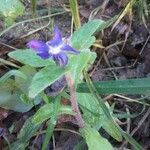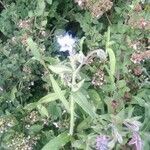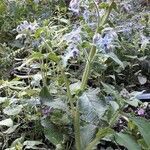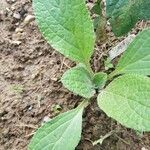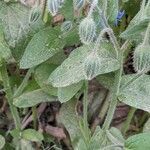Annual, sometimes biennial. Stems and lvs strigosely hispid. Basal rosette lvs to c. 30 × 20 cm, lanceolate, ovate or broadly ovate, petiolate; base usually rounded or cuneate; apex acute; stem lvs much smaller, becoming sessile and slightly amplexicaul in upper stem. Pedicels to c. 3 cm long, becoming deflexed. Calyx c. 10 mm long at anthesis, elongating at fruiting; lobes linear or linear-lanceolate. Corolla limb c. 2.5 cm diam.; lobes slightly directed backwards, ovate-lanceolate or lanceolate, acute, blue, occasionally white. Staminal cone erect, c. 10 mm long, acute, black or nearly so. Nutlets 5-8 mm long, with irregular longitudinal ridges.
An annual herb. It is a sprawling plant. It can be 45-75 cm high and spread 45 cm wide. The stout stems and leaves are covered with stiff hairs. The lower leaves are on leaf stalks that have winged extensions near their base. The upper leaves are smaller and have blades without stalks. The flowers are blue or pink and star shaped. They have black centres. The flowers are on stalks 1.5-4 cm long. They are in clusters on the ends of branches. The nutlets are brownish-black. They are wrinkled and have a base which curves inward.
Taprooted annual 2–6 dm, hispid-setose and hispidulous; lower lvs petiolate, with broadly elliptic or ovate to oblanceolate blade 3–11 × 2–6 cm, the others progressively reduced and the upper often sessile and clasping; pedicels 1–4 cm; sep densely bristly, 1–1.5 cm in fr; cor 2 cm wide; anthers dark, 5–9 mm, the linear appendages 3 mm; nutlets subcylindric, 4–5 mm, rough and wrinkled; 2n=16. Native of Europe, sometimes cult., and established as a casual weed here and there in our range. May–Sept.
